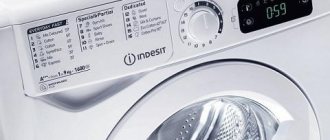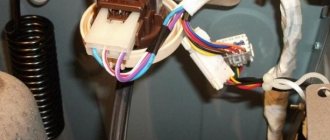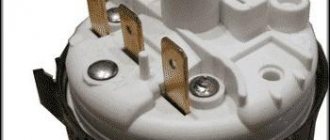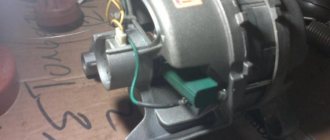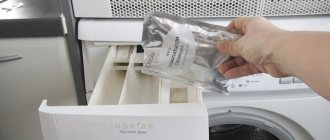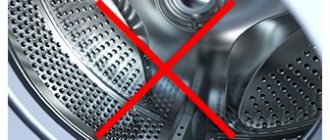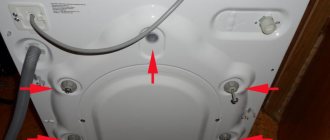Design and principle of operation of an automatic washing machine
Regardless of the brand of automatic washing machine, the design of front-loading models is almost identical from different manufacturers. Any owner should understand the structure of such equipment. This will help you understand how the automatic machine works, what could fail due to various problems, and whether you can handle the breakdown yourself.
The main components of the automatic machine include:
- Frame;
- Tank;
- Drum;
- Water filling system;
- Pressostat;
- Electric motor;
- heating element;
- Drain system;
- Control block.
Motor capacitor
Got a whiff of smoke? Did it smell like burning? There is only one conclusion - problems with the electric motor. Operation of the machine is not recommended. The problem is not a “cheap” one. But don’t rush to despair, perhaps the problem is a cheap one. The capacitor is broken. Check the instructions: Repairing washing machine circuit boards. Don’t rush into asking the technician to replace the motor - try replacing the capacitor, and most likely you will continue to use the machine for a long time.
So, if you decide to independently repair certain control boards of the Indesit unit, you should strictly follow the operating instructions and not act spontaneously.
One of the most reliable parts of the Indesit washing machine is the electric motor. Most often, its resource is much higher than that of other nodes, however, sometimes it fails. Motor malfunction is determined simply - with normal indication, the drum does not rotate in any of the modes.
Access to the engine is easy. It is located under the drum next to the drainage system and shock absorber. It’s just that diagnosing it will require special equipment and knowledge, but it can be easily removed in order to take it to a workshop or replace it with a new one.
In many cases, repairing a washing machine yourself brings the expected results. It is possible to save on calling a specialist, while the machine works normally. True, this only applies to cases of minor damage or blockage. In the event of a serious accident, you cannot do without calling a technician or visiting a workshop.
You may also be interested in reading:
- How to troubleshoot Ardo washing machines
- Indesit wisl 82 washing machine operating instructions in Russian
- Beko washing machine errors - how to fix them
- The washing machine leaks from below during washing and when drawing water
Frame
All elements of the washing machine, regardless of the brand - Indesit, LG, Samsung, Ariston, Electrolux, Bosch or another, are located inside its metal body. The case consists of a base, a front panel with a hatch, a top cover, side walls, and a back wall.
At the top of the front wall of the case there is a control panel, and in the left corner there is a container for loading detergent (dispenser). Typically, such a container has 3 cells (two for powder and one for liquid), but there may be more or less of them depending on the model (from 1 to 5). The powder loaded into the dispenser through one or more pipes enters the tank under the influence of a stream of water.
In the center of the front wall there is a hatch for the washing machine. It contains parts such as a rubber cuff for the hatch and a device responsible for blocking the hatch during washing. Inside, the cuff is attached to the tank using a clamp. Thanks to the locking device, the door cannot be opened during the washing process. Most often, such a device has a thermocouple, so after finishing the wash the door remains closed for some time.
Clogged drain lines
If the machine drains water very slowly, the washing program stops in the rinse or spin mode, it is likely that the drain system is clogged. Similar malfunctions of the Indesit washing machine can arise as a result of the life cycle of the machine; contamination can accumulate during the washing process, or it can appear spontaneously. In the second case, the reason for the sudden breakdown is clear - something got into the drain.
Drain pump
The drain system consists of several main parts and any of them can become clogged:
- a pipe that drains water from the drum;
- pump;
- filter;
- drain hose into the sewer.
You should start by checking the filter. To access it, you must remove the bottom of the front cover. Unscrew the filter by rotating it counterclockwise.
Tank and drum
The tank is considered the main and most voluminous element of an automatic machine. It can hold 35-60 liters of water. To prevent the machine from vibrating excessively during washing, the tank is not rigidly connected to the body. To support it, there are two or four springs at the top of the machine, and two or four shock absorbers at the bottom. In addition, to eliminate imbalance and strong vibration of the tank during washing, concrete counterweights are attached to it. Thanks to this design, the body remains motionless during operation of the equipment, despite the vibrations of the tank.
Inside the tank there is a drum connected by a belt drive or direct drive to the engine. Laundry is loaded into the drum, and after the washing program is turned on, water and detergent begin to flow into it through many holes. At the front, the tank is connected to the drum by a rubber cuff, which ensures tightness, and at the rear, the drum shaft passes through the tank to the bearing unit.
Stainless steel is usually used to make the drum, and the tank can be either steel or plastic. The second option is cheaper, but is more fragile and has a shorter service life. Often the tank has two halves, which are connected with bolts or with a clamp, but in many machines there are non-separable tanks.
The machine does not pick up washing powder from the tray
A fairly common malfunction of a washing machine is that water does not flow into the powder compartment, or the pressure is too weak. The cause may be low pressure in the water supply or a clogged inlet valve. You definitely won’t be able to solve the low pressure problem on your own, but you can check the valve.
The inlet valve is located at the rear of the machine, approximately at the level of the powder tray. To check and clean it, just unscrew the hose, rinse the mesh and screw it back on.
Drain system
The main elements of the drainage system of an automatic machine are a drain pump and a plastic corrugated drain hose 1-4 meters long. One part of the hose is attached to the pump using a clamp, and the second is discharged into the sewer system.
Draining should normally be performed several times during washing. The pump consists of a motor, an impeller and a “snail” to which the hoses are connected. The pump is most often synchronous. The operation of the pump is controlled by an electronic module.
Control block
This unit of the washing machine commands all other elements, so it can safely be called the “brain” of the device. It is also called a programmer, electronic board or control module. It is from such a block that commands are issued that are carried out by the fill system, heating element, drum, drain pump and other parts.
The control unit is the most complex and expensive part of the washing machine. Its device has a digital indicator, thanks to which the user knows everything about the operation of the device. In most models, if there is a malfunction, such an indicator begins to show an error code. Having learned its decoding, you can determine what the breakdown is and whether it can be dealt with without calling a technician. If the module itself fails, you should contact a specialist to repair or replace it.
Electronic module malfunction
The electronic control module consists of electronic boards that provide operation of the corresponding programs and display. Only professionals can repair the program control unit. For this purpose, the control module diagram of the Indesit washing machine is used. What is available to you is to check whether there is water on the unit and how securely the power outlet is grounded. If you are ready for independent repairs, then see the appropriate place in the instructions: repairing washing machine circuit boards.
The electronic module controls the operation of the washing machine.
Electronic module of the Indesit washing machine
- refusal to launch the program;
- chaotic switching of operating modes;
- freezing (the system does not respond to the owner’s actions);
- blinking indicators;
- significant increase in washing time.
Sensors
The operation of the control module is based on monitoring various sensors that send information to it about all processes in the machine during washing.
Such sensors are:
- Pressostat. This is the name of the sensor whose function is to monitor the water level. Another name for it is level relay. It can be electronic or mechanical, and its operating principle is pneumatic. As soon as the pressure switch sends a signal to the control module that there is enough water in the tank, the machine will continue to operate.
- Air chamber. This plastic part is located next to the drain pipe and is important for the operation of the pressure switch. When the tank fills with water, the air pressure in this chamber increases proportionally with the water pressure. Through a small fitting, the pressure is transferred to the pressure switch.
- Thermostat. This sensor is located at the bottom of the tank. The main function of this sensor is to determine the temperature of the water in the tank and transmit data to the control module.
- Tacho sensor. Its main job is to control engine speed, which is important for different washing modes and the spin process.
Heater
The heating element located inside the washing machine is responsible for heating the water during the washing process. The heater power most often ranges from 1800 to 2200 W. It is located at the bottom of the tank and is considered one of the most vulnerable elements of such equipment. Its breakdown is one of the most common and most often occurs due to the accumulation of scale on the surface of the heater.
Engine
The main function of the motor in a washing machine is to ensure the rotation of the drum. Most often, an automatic machine has a commutator motor, but you can find models with a brushless or asynchronous motor.
In direct drive models, the motor is mounted to the drum (to its rear wall). This type of electric motor in a washing machine is called more efficient. Its rotation requires less energy, and the vibration and noise levels from a direct drive machine will also be less. In addition, such an engine takes up less space, which allows you to create machines with compact dimensions.
Belt drive models have a pulley located at the rear of the tank. It is connected to the engine via a drive belt. When turning on the motor starts the movement of the belt, the pulley begins to rotate and thereby ensures the rotation of the drum. The main disadvantage of this machine design is the wear of the belt under the influence of friction. In addition, such a washing machine vibrates more during operation than direct drive models.
The structure of the washing machine and its operating principle are well described in the following video.
Source
About the features of automatic washing machines
Each device is supplied with a housing. There is a metal frame with a front panel. Additional elements - a wall at the back, a lid with a base. Working units and mechanisms are located inside the housing. They are responsible for performing the functions assigned to the units. LG and many other models are no exception to this, the same can be said about the design of the Indesit washing machine, which will be discussed further.
Control panel display
Most models of Indesit washing machines have a built-in self-diagnosis system. The system checks the functionality of the components and signals if a malfunction is detected. Error codes, as well as indication methods, can be found in the documentation for the washing machine. The presence of such a system greatly simplifies troubleshooting and, therefore, the likelihood of successful elimination.
The result of the system operation is errors of the form F01 - short circuit of power circuits, F03 - temperature sensor is faulty, F07 - tank fill sensor does not work.
Main nodes
The design consists not only of basic, but also of additional modules. The main principle of operation is the clear interaction of components with each other. We list a number of components that are present in the design of any washing machine:
- Electrical engine;
- control panel with electronic module support;
- the circuit includes a heating element and electrical equipment for it;
- shock absorbers with springs;
- valve responsible for collecting washing liquid;
- drain pump;
- housing with a rear wall and a hatch-shaped cover;
- assembly with bearings;
- drum, tank
When not to start repairs
Before you take up a screwdriver, you should soberly assess your strength. A washing machine is a rather complex electrical appliance and you need to start repairing it only with the appropriate skills. But even if the owner’s qualifications allow one to count on a successful outcome, there are several situations in which it is better not to start independent repairs.
- The machine is under warranty. Any attempt at home repairs will inevitably entail the manufacturer’s refusal of warranty obligations. Before the warranty expires, the correct solution to any problem is to contact a specialized service center.
- The control unit is faulty. It is unlikely that such a breakdown can be corrected on your own. The only correct solution would be to call a technician or send the machine to a service center.
- Violation of the integrity of the drum. The drum of the Indesit washing machine is made of very thin metal. Its design does not imply repair. In this case, to correct the situation, only replacement is possible. Of course, if there is no craftsman at hand who can weld the thin steel of the drum with pinpoint precision.
- Replacing bearings. The design of most Indesit models makes it quite easy to replace the drum bearings. But not everyone. Some models simply do not provide for such repairs. If the bearings fail, there is only one way out - you need to buy a new machine.
Basic rules of work
Any LG device is equipped with a so-called tank. It does not have a rigid connection to the body. This is done to avoid strong vibrations. There are two shock absorbers at the bottom for support, and springs at the top. The body remains motionless, although the part itself vibrates actively when everything starts to work.
The drum of the LG washing machine is located inside the tank with a mount. Without bearing units, no design will work. Through a belt drive, the electric motor begins to rotate along with the rest of the structure. Some models have direct drive.
Features of the tank and drum
This is the name of the containers responsible for loading laundry into Indesit. First, water is supplied to the tank, and then it is heated to a certain temperature. The detergent goes into the same container. Small holes are usually used for this. Thus, the water comes into contact with the laundry. This is the main principle of LG and other models.
The main material for the manufacture of drums is stainless steel. The tank can also be plastic. This is a lighter weight, more affordable option. But fragility and fragility remain serious drawbacks for many. Tanks are most often located horizontally, but they can also be inclined.
Machine device
The main thing during repairs, and this applies not only to the washing machine (WM), is to correctly diagnose the malfunction. To perform diagnostics yourself and then eliminate the cause of the problem, you need to understand the structure of the unit and the principle of its operation. All washing machines are designed and work the same.
- Frontal. Access to the tank is through a horizontal hatch in the front of the machine. A special door opens to load laundry. When the SM is operating, its opening is blocked using an electronic lock (UBL) and is unlocked only after the washing process is completed. The door itself is inserted into a cuff that prevents water from leaking. For example, model W105Tx.
- Vertical. There is no hatch as such for loading laundry in this type of SM. Instead, the door located on top rises. After lifting it, to access the inside of the drum, you still need to snap off the lid. This type is equipped with a mechanical latch. After starting the wash, you can interrupt the process, add or remove laundry from the tank. For example, as in the WT80 model.
But at the same time, statistics on repairs indicate that the vertical type breaks down more often. This is due to the fact that “vertical” units have a denser arrangement of units, which means that vibration during washing is transmitted from one unit to another much stronger than with the frontal type. As practice shows, it is more difficult to find spare parts for the vertical type. Although, in terms of assessing the degree of maintainability, both types are equal.
In general, the design of washing units is the same. It combines both mechanical and electronic components. All components and blocks are hidden inside a metal case. It is assembled from four parts: a base and three covers. The main components directly involved in the washing process include:
- Electronics board. This is an electronic module with the help of which the operating modes of the SM are set. A control unit and various sensors are connected to it to determine what stage the wash is at. So during operation, the electronic module also controls the execution of various tasks.
- Pressostat. Device for monitoring the water level in the unit tank. This sensor can measure the pressure created and send data to the electronics board. The latter processes the data and sends a command to the water intake valve to close.
- Valve. An electromechanical device installed at the water supply inlet to the SM. It uses inductors. Applying voltage to them causes the membrane to open and water to enter the tank.
- Tachogenerator. This sensor is used to count the number of revolutions of the tank. With its help, the rotation speed is adjusted.
- Thermal heater and temperature sensor. With the help of a heating element, the water is heated, and the sensor monitors its temperature. As soon as it reaches the required value, the control board turns off the current supply to the heater.
- Electric motor. It differs in the type of installation: direct (inverter) and collector. If the first drum is connected directly, then the second one is connected through a belt. The motor structure consists of a stator, rotor and brushes.
- UBL. Hatch locking device. Protects the hatch from accidental opening. The operation of the UBL is based on the property of a bimetallic plate to bend under the influence of temperature. When the SM starts, current is supplied to the plate, it warms up and presses the lever that blocks opening.
- Pump. A pump is used to drain water from the tank. It consists of a motor and an impeller, which are placed in a plastic casing made in the shape of a snail.
- Drum. It is located inside the tank and is made of cylindrical shape from stainless steel or plastic. The rear part is connected to the tank cross. The inside of the tank is perforated.
Principle of operation
The washing process consists of several stages. It is impossible to repair the SM without knowledge of them. After the laundry is loaded into the tank, the powder is poured into the dispenser, and the user presses the start button, the following happens:
- The electronics board supplies voltage to the UBL terminals, as a result of which the opening of the hatch is blocked (only for horizontal models).
- A signal is sent to the electric motor. It transmits reverse movements to the tank to evenly lay out the laundry. Turning of the laundry occurs due to the protrusions inside the drum. At the same time, the membrane opens and water begins to flow into the middle of the tank.
- When the required level is reached, the pressure switch is activated. At his command, the damper closes.
- If the program includes washing in hot water, the heating element turns on.
- According to the established program, the drum begins to perform rotational movements at different speeds and in different directions.
- As soon as the program is finished, the programmer sends a signal to the drain pump. The latter turns on and begins to pump out water. This happens until the water level sensor signals a stop.
- Rinse mode starts. According to the programmed algorithm, water flows into the tank again, and it begins to rotate. The process can be repeated several times.
- Spin starts. During this, the drum of the machine rotates at high speed, and water leaves through the perforations from the drum into the tank. From there it is pumped out by a drain pump.
Quite a common malfunction. To fix it, you should start by checking the outlet; here you can use an indicator or simply plug in some other electrical appliance. If the socket is working, you should check the plug and power cord. The machine does not heat the water or does not start washing with warm water.
Heating element of the Indesit washing machine
Replacing the heating element can be done at home; the element itself can be easily purchased in a store.
Read more: Ventilation in an apartment with your own hands: how to make an effective system
The heating element is located under the drum; to replace it you will need to remove the back cover of the machine. The work sequence is as follows:
- the machine must be de-energized;
- disconnect the water supply and drainage hoses;
- turn the machine over, remove the back cover;
- remove the drive belt;
- remove the broken heating element and install a new one;
- assemble the machine, connect the hoses and power supply.
The process of removing the heater is not particularly difficult. It is secured with one screw and connected with three wires. It is enough to remove the terminals, loosen the screw and pry the heater with screwdrivers to remove it.
How is water heated?
A special element called ten is responsible for this. It is usually installed at the bottom of the washing machine tank. 1800-2200 W is the average power at which any modern heating device should operate. If the machine consumes a lot of energy, it is because of the heating element. And it acts as the “weakest link” in the design.
A commutator motor inside the drum is the most common option. But there are other options, their principle is almost the same:
- brushless;
- asynchronous three-phase.
A device that does not use belts is considered more effective.
Draining and collecting water. We manage the process
The control module sends signals to the machine, and they help control the process of drawing water into the washing machine. The solenoid valve takes an active part in this process. The inlet hose is permanently connected to it.
The washing structure also has an electric pump responsible for draining the water. This part is also called a pump. This process is also controlled by an electronic module. During one washing cycle, the water is drained several times. First after the main wash has finished. And then every time after rinsing.
The main thing is that there is always open access to the pump, because it must be cleaned periodically.
More information about the pump itself
In most modern models, including LG and Indesit devices, it is a type of electric motor with low power. It consists of an impeller mounted on a shaft. The impeller itself is located inside a sealed housing equipped with two pipes. One is needed for water intake, and the second is for draining. This is the basic principle.
What technical characteristics does it have:
- operated in water with a temperature of no more than 90 degrees;
- 1 meter – maximum level of water rise;
- 20 liters per minute is an indicator of productivity;
- 160 Ohm plus minus 5 percent – winding resistance;
- 30 W is an indicator of rated power.
Malfunctions of Indesit washing machines and their elimination
The main malfunctions of Indesit washing machines are malfunctions of their main components, such as:
- drain pump;
- washing mode switch;
- drum bearings;
- tank shock absorbers;
- control module;
- inlet solenoid valve;
- electric motor;
- network filter;
- hatch cover locking device.
Most of them are completely removable on their own. If you call a specialist or send the equipment to a workshop for repairs, its cost will be very significant.
The main symptoms of a malfunction of this unit are the following:
- When draining water, the pump operates with a loud rattling sound, and a fine vibration is felt on the body.
- The pump does not pump out the water accumulated in the tank, while emitting a monotonous low-frequency sound (“mooing”). It’s better to read why the washing machine does not drain water.
- Water is not pumped out, and the pump itself does not make any sounds at all.
- Water is pumped out of the tank very slowly.
The easiest way to fix this problem is to clean the pump filter.
To do this, unscrew the lid located in the lower right part of the unit and manually remove from there all foreign objects (coins, buttons) that have fallen through the gap between the cuff and the rotating drum.
At the same time, you should also carefully turn the pump impeller by hand: if, after cleaning the filter and removing foreign objects from the pump, it spins without effort, then the main cause of the malfunction has been eliminated.
If the problem is not resolved after cleaning the filter, perform a more thorough repair of the pump as follows:
- Using a drain hose located near the pump filter, drain all the water from the tank.
- Open the filter hatch and unscrew the two screws located near its plug.
- Putting the car on its side, remove the bottom cover - the bottom.
- The pump is disconnected from the tank drain pipe and the sewer hose.
- After disconnecting the power connector from the pump, the pump is removed from the washing machine body.
- By unscrewing the two screws or turning it counterclockwise, the “snail” is removed from the unit - the working part of the pump with two pipes.
- Using a heat gun, heat up and carefully remove the pump rotor with impeller and seal from the housing.
- Clean the magnetic rotor from dirt and water and lubricate its bearings.
- Replace the oil seal and install the rotor in its original place.
- Install the pump in the reverse order of dismantling.
Be sure to read:
Water flows into the washing machine when it is turned off: reasons and what to do
If after such manipulations the pump does not work, it should be replaced with a new one of the same model or an analogue approved by the manufacturer.
The main malfunctions of this control unit are burnout of electronic components - capacitors, resistors, microprocessor (controller), caused by voltage surges, short circuits due to high humidity or water getting on the board, or their manufacturing defects.
Due to the failure of this unit, the machine completely or partially stops responding to pressing buttons on the control panel, the duration of various modes is disrupted, and error codes consisting of a Latin letter (F or H) and two numbers (01 or 018) appear on the display.
Each of them means a specific malfunction of a specific component of the washing machine. They can be deciphered using a special table given in the unit’s operating manual.
You cannot repair the control module yourself; to do this you must have soldering skills, a special soldering station, and knowledge in the field of radio electronics. Troubleshooting of this board is carried out by specialists from service centers.
If the machine vibrates strongly during the spin cycle, hums or makes a whistling, cutting sound, an urgent replacement of the drum bearings and seals is necessary.
This unit is replaced as follows:
- After unscrewing the two screws, the top cover is moved forward and removed from the machine.
- All connectors are disconnected from the control module, the latches securing it on the front panel are pressed out and removed from the washing machine.
- Carefully removing the spring clips from the front panel and tank, disconnect the flexible rubber cuff.
- Remove the front panel (cover).
- Disconnect the filler and drain pipes.
- After unscrewing 2 screws, remove the powder receptacle.
- Using a socket wrench, unscrew and remove the top and front concrete counterweights.
- Having unscrewed the back cover from the tank pulley, remove the drive belt (for models with a belt drive), and disconnect the power wires from the heating element and the electric motor.
- Putting the car on its side, remove the bottom of the unit, and disconnect the tank shock absorbers from the body of the unit.
- Having disconnected the two upper springs from the body, the tank is removed from the body through the upper part.
- Having locked the pulley using a socket wrench, unscrew the nut securing it to the drum shaft.
- The tank is sawed along the solder seam with a hacksaw.
- The drum is removed from the tank.
- The seals are removed from the bushing, and then the failed bearings are carefully knocked out.
- The bearing seats are thoroughly cleaned of dirt.
- New bearings are inserted into the bushing and, using old bearings, carefully driven into the seats.
- The bearings are sealed from above with new seals.
- The drum shaft is inserted into bearings.
- The sawn tank is connected using bolts and sanitary silicone sealant.
- The tank is installed in the reverse order of dismantling.
Read more: Do-it-yourself Venetian plaster using ordinary putty: master class
This bearing replacement process requires careful adherence to the sequence of steps described above.
If the water does not heat up during washing, the machine does not start, displaying an error code corresponding to a malfunction of the heating element, it is removed from the tank and checked for serviceability as follows:
- Remove the back cover.
- Disconnect the power and ground wires from the heating element.
- Disconnect the temperature sensor.
- Unscrew the nut on the stud in the middle of the heating element.
- Press the pin into the tank.
- Using a screwdriver, pry the flange of the heating element and carefully remove it along with the sealing rubber from the tank.
Be sure to read:
The washing machine does not turn on: causes of problems, what to do
After removing the heater from the tank, it is first checked for functionality using a multimeter. To do this, set the device to resistance measurement mode in the range of up to 200 Ohms, applying the probes to the terminals of the heating element.
The value that appears on the multimeter display should be equal to or slightly less than that calculated by this formula: R=U2/P, where U is the voltage supplied to the heating element in volts (V), P is the heater power in watts (W).
So, for example, for a heating element with a power of 2000 W operating from a conventional two-phase network with a voltage of 220 V, the normal resistance will be 24.2 Ohms.
After this, the heater is checked for breakdown. To do this, turn the multimeter into buzzer mode, one of its probes is applied to the contact of the heating element, and the second to the ground or the descaled surface of the heater.
If at the same time the multimeter makes a characteristic long sound (squeaking), it means that the spiral inside the heater body is in contact with it, thereby creating a danger of electric shock to a person through the body of the washing machine. This heating element must be replaced.
If the heating element turns out to be serviceable as a result of these checks, it must be descaled. To do this, the heater is dipped into a pre-prepared solution of vinegar or citric acid and kept in it for 24 hours.
Replacing the shock absorbers (dampers) located at the bottom of the machine is carried out as follows:
- The back cover is removed.
- The upper locking pins are removed from the shock absorbers inserted into the eyes on the tank - to do this, remove the stoppers from them or clamp special locking latches.
- Having disconnected the lower pins or bolts securing the dampers to the machine body, they are freely removed and inspected for functionality.
It is recommended to replace shock absorbers not one at a time, but in pairs, using the markings applied to its body when selecting.
The main reasons that powder remains in the tray during washing are:
- Insufficient water supply to the tray - can be eliminated by repairing or replacing the solenoid inlet valve and cleaning the mesh inlet filter.
- Too much powder poured into the tray - you must strictly follow the amount of powder recommended in the machine’s operating instructions for each washing mode.
- Failure of the electronic control module - this problem can only be solved by a highly qualified technician or service center specialist.
Also, excessive accumulation of powder in the tray may occur due to the use of low-quality, expired detergent.
If water does not flow into the powder container, this may be due to the following reasons:
- clogging of the input filter mesh;
- breakdown of the intake solenoid valve;
- There is insufficient water pressure in the hose connected to the washing machine.
Also, the absence or lack of water in the tank may be caused by a malfunction of the control unit.
The main malfunctions of the washing machine motor are:
- brush wear;
- reservoir development;
- breakage of the rotor windings;
- destruction and jamming of bearings.
Be sure to read:
The structure of an automatic washing machine: the principle of operation, what it consists of
These faults are eliminated by replacing failed engine components (brushes, bearings). If the integrity of the armature winding is damaged or the commutator unit is worn out, the engine is replaced with a new one.
If the machine hatch does not lock during the washing process, this may be caused by:
- Failure of the locking mechanism itself - the hatch locking device (UBL) based on a thermoelement and a bimetallic plate.
- Failure of the control module.
In Indesit washing machines, if the UBL fails, its disassembly and repair due to the non-separable design of this unit is impossible. A failed hatch lock must be replaced with a new one.
If the mode switch knob (programmer) turns freely, but the hatch does not lock and the machine does not start, this may be caused by a breakdown of the following components:
- water pump;
- heating element;
- temperature sensor;
- pressure switch (water level sensor in the tank);
- control module;
- engine speed sensor;
- electric motor
About additional details
Front-type counterweights are present only on some models. This is necessary to compensate for the imbalance. The shape, material, and weight of such inserts may vary.
The counterweights themselves are blocks with a fairly large weight. They can be plastic or concrete. The latter have a serious drawback - the ability to deteriorate and crumble over time. But most often serious problems arise due to mounting on counterweights. Because of them, the seat of the bolts is destroyed.
To transfer torque from the electric motor to the drum, you need a special belt. Most often, rubber is used to make such parts. But some manufacturers put belts made of polyurethane, neoprene and nylon inside their cars.
Drive belts are available in several varieties:
- groups Z – almost every device from Russia is supplied with them;
- H – found in small cars;
- J is a diagram for devices with large dimensions;
- 3 L – found in foreign analogues. LG, for example.
A wheel is fixed to the drum shaft, which is called the driven drum pulley. It also participates in transmitting the movement of the drive belt. The diameter of this structure determines what the maximum number of revolutions in the machine will be during operation. Aluminum alloys are very fragile materials, from which this pulley is almost always cast. This also applies to Ardo models.
Shock absorber, springs and relays, other accessories
Shock absorbers are needed to dampen vibrations arising from the tanks. One of the sides is connected to the base. The other side is connected to the tank. Bearings wear out much faster if the shock absorber is faulty. Other parts also suffer due to this problem. As a result, the engine is damaged during operation.
Thermal energy is what the reciprocating movements of the pistons turn into. The transformation takes place inside the cylinder. A non-drying high friction lubricant coats the shock absorber gasket. The return spring is responsible for the return stroke of the piston.
The spring mount is also located at the top. The housing in the device and the tanks are connected by springs. Typically it consists of 2-4 springs and shock absorbers. Their main task is to compensate for the vibrations that occur inside. Therefore, owners select the characteristics of shock absorbers and the level of stiffness for springs accordingly.
Relay is a device responsible for controlling the water level. It looks like a type of cylindrical box. The part is equipped with terminals and switch contacts. A tube goes from the high-pressure reservoir to this part, and wires are supplied separately.
About electric motors
Washing machines use several main types of motors:
- three-phase stepper is the rarest. They are supplied to premium Indesit cars;
- asynchronous three-phase – characterized by operation without additional noise;
- collector - the simplest models. They are installed in economy class equipment.
Revolutions per minute are the main characteristic for the engine of any washing machine, including Indesit and LG. They help to understand how efficiently the device works.
Source
Troubleshooting
Before you start repairing the Indesit washing machine with your own hands, you need to listen to it. The fact is that a large number of malfunctions are caused by extraneous sounds that the mechanisms make during operation. This applies to bearings, shock absorbers, and pump malfunctions.
If there are no extraneous sounds or vibrations, you will most likely have to disassemble the machine. But before starting work, you should carefully study its structure and understand the sequence of actions.
It would also be a good idea to check the integrity of the power cord and the presence of voltage in the outlet. Quite often the causes of a malfunction are in plain sight.
Read more: Don refrigerators: TOP 5 best models, selection tips, reviews

